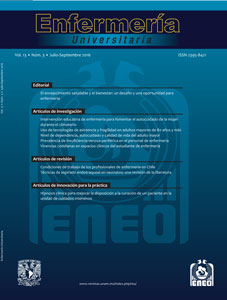Assisting technologies and frailty in aged 80 years and older
Main Article Content
Abstract
Objective: To identify and analyze the association between the use of assisting technologies and the frailty in aged 80 years and older.
Method: This is a quantitative, descriptive and transversal study conducted in Ribeirão Preto, Brazil, with a sample of 144 aged 80 years and older of both sexes and living in the community. Data were gathered through the Edmonton Frail Scale (EFS), and the Assisting Technology Instrument. Data were analyzed using descriptive statistics and Fisher’s exact test at a significant level of p < 0.05.
Results: A prevalence of females, widowed, and living alone was observed. From those interviewed, 77.4% used some assisting technology, mainly lenses and supporting banisters. Concerning frailty assessment, 23.6% were considered as mild, 13.1% as moderate, and 7.8% as severe. A statistically significant association with the use of assisting technologies such as wheel chairs, banisters, and walkers was verified at all frailty levels.
Conclusion: The use of assisting technologies can help elder adults achieve a more functional independence and autonomy in their daily life activities.
Publication Facts
Reviewer profiles N/A
Author statements
- Academic society
- N/A
- Publisher
- Universidad Nacional Autónoma de México
Article Details
Dimensions citation
MÉTRICAS
Enfermería Universitaria by Universidad Nacional Autónoma de México it is distributed under the License Creative Commons Attribution - NonCommercial - NoDerivatives 4.0 International
Accepted and published articles become open-access under the terms of the Creative Commons CC BY-NC-ND 4.0 license, which authorizes the reproduction and sharing without commercial purposes, provided the corresponding acknowledgments to their authors. Authors are allowed to manage a self-archive copy of the article’s published version so that they can open-access it in their personal or institutional web pages, and/or any other broad-diffusion space.





